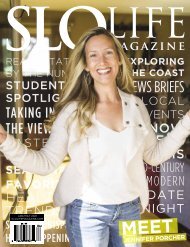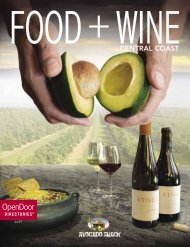SLO LIFE Jun/Jul 2017
Create successful ePaper yourself
Turn your PDF publications into a flip-book with our unique Google optimized e-Paper software.
| STORYTELLERS’ CORNER<br />
THE STORY OF<br />
YOUR <strong>LIFE</strong><br />
BY FRANZ WISNER<br />
“I<br />
feel like I have a good story inside me… I’m just having a hard time<br />
getting it out.”<br />
I hear this sentiment frequently from people thinking about penning a memoir. In response,<br />
I nod my head and offer a hug. I know the feeling well, having set the world record<br />
for staring at a blank computer screen, wishing for the sentences to magically appear.<br />
Unfortunately, Apple has yet to create an app for that.<br />
FRANZ WISNER is the<br />
founder of The Bestsellers<br />
Group, which provides<br />
brands and individuals with<br />
storytelling assistance from<br />
bestselling authors.<br />
How to write a memoir<br />
So to anyone out there interested in writing a memoir, take a deep breath, pour yourself a<br />
glass of wine, and let’s get started, shall we?<br />
A good place to begin is what a memoir isn’t. Your memoir shouldn’t be a journal or a<br />
travelogue, a therapy recap or a settled score, a self-love-fest or a thank-you note to everyone<br />
in your life. Those approaches might be fascinating for you. For the rest of us? Not so much.<br />
A memoir isn’t your entire life story; rather it should be the most compelling parts of your<br />
life story. “Writing a memoir is easy,” counseled a friend of mine as I struggled with my first<br />
book. “Just keep the interesting bits and cut out the boring stuff.”<br />
So stop looking at your life as a chronology of events. See it in thematic terms. Ask yourself,<br />
what is my story about?<br />
Readers aren’t as interested in the surface action. We don’t want to hear a basic reporting of<br />
events. We want to know what’s really going on. We want the inside scoop, the story you<br />
would tell a best friend. If you had to describe your book to us in a sentence or two, what<br />
would you say?<br />
Popular memoir themes include coming-of-age tales; stories<br />
of recovery or discovery, rebirth or renewal; quests, missions,<br />
or escapes; rags-to-riches or riches-to-rags narratives; or even<br />
a collection of short stories that together form a greater whole.<br />
Your theme could be one of these, a combination, or something<br />
you create on your own.<br />
Still not sure? Try a few themes on for size. Take a look at<br />
other memoirs. How did the author frame the book? If that<br />
doesn’t help, ask fellow writers how they see your story. Their<br />
answers may trigger an approach you hadn’t considered.<br />
Summarizing your life story in a few words can take a lot of<br />
time and, gulp, thought. For some, it’s the hardest part of the<br />
process. Just know that once you finalize the theme, everything<br />
else becomes easier.<br />
The theme becomes our road map from this point. It<br />
lets us know where we are taking our readers and helps<br />
us decide what stops we should make along the way.<br />
Next, list out all the events in your life you think<br />
might make for an interesting part of your book. If<br />
you were making a movie of your life, these would<br />
be all the potential scenes. They could be big events<br />
or small, memorable times shared with others or key<br />
moments alone.<br />
I do this on three-by-five cards. At the top of the card,<br />
I write a sentence that summarizes the surface action.<br />
Underneath, I write another sentence that outlines the<br />
emotional underpinning of the scene. So, for instance,<br />
the surface action could be the birth of a child while<br />
the underlying emotions may include a whirlpool of<br />
joy, pride, fear, insecurity, and giddiness.<br />
I list out the date and location of the scene along with<br />
all the characters involved. I also give each scene an<br />
intensity rating, a number between one and five—ones<br />
and twos for mild or everyday occurrences, fours and<br />
fives for those high-adrenaline moments. I finish<br />
each card with an arrow pointing up for a cheery<br />
scene, down for a downer moment, or sideways for<br />
something in between.<br />
Next, I arrange all the cards in chronological order on<br />
a long table. This allows me to begin to “see” the story.<br />
I try to keep an open mind during this process as I<br />
believe stories have a life of their own. If you listen to<br />
them, they will tell you which portions to emphasize<br />
and which ones to discard.<br />
This is one of my favorite parts of the process. I love<br />
experimenting with story structures. Maybe I start<br />
with a big, dramatic scene, then go back in time and<br />
tell the story of what led to that moment. Maybe<br />
I combine a couple smaller scenes to make a more<br />
compelling chapter.<br />
The whole time I ask myself, “Does this scene further<br />
my story’s theme?” If it does, I keep it in. If not, I cut it<br />
out and paste it in the “Save for Another Book” file.<br />
The same goes for characters. Uncle Ralph might be<br />
a wonderful man, but if he has little to do with your<br />
story’s theme, he’s got to go. You can thank him in the<br />
acknowledgments, or at the family reunion.<br />
I also use the cards to help me make sure my memoir<br />
includes all the essential story elements—beginning<br />
with conflicts and challenges, followed by rising action<br />
(the steps taken to overcome the conflict), ending with<br />
discovery, and a satisfying resolution.<br />
Then, presto. Before I know it, the framework of a<br />
book begins to appear in front of me.<br />
That story inside has started to emerge. <strong>SLO</strong> <strong>LIFE</strong><br />
78 | <strong>SLO</strong> <strong>LIFE</strong> MAGAZINE | JUN/JUL <strong>2017</strong>


















